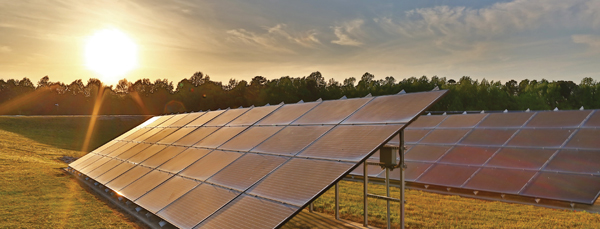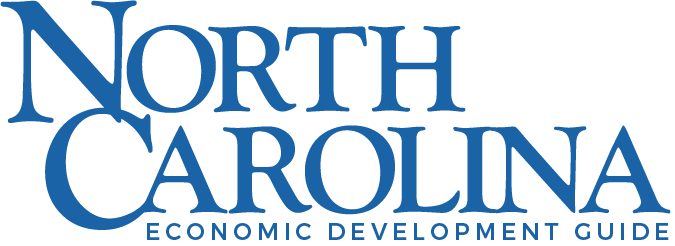Focus: Eastern region, power of attraction
Eastern North Carolina has a thriving solar energy sector, among other attributes. Now a similar passion is building for developing wind and other alternative energy sources, aided by the region’s ample supply of land and workers.
—By Kathy Blake and Teri Saylor
Amy Braswell has a unique perspective on building pros-perity in her community. In addition to managing her family’s 600-acre farm in Hertford County, she is Ahoskie Chamber of Commerce’s executive vice president, recruiting businesses, industry and jobs.

Solar farm in North Carolina
Lately, Braswell’s focus is on renewable energy. And in December 2020, when she accepted a North Carolina Clean Energy Champion award from San Francisco-based Chambers for Innovation and Clean Energy, she expressed optimism that renewables would spur further economic growth. “Hertford County is a mix of industries and agriculture, and we are now adding renewable energy to our portfolio,” she said during the ceremony. “We see the opportunity, and we are absolutely certain that renewables will play a role in our future economic development planning.”
Hertford County abuts Virginia and the Chowan River in northeastern North Carolina. It’s home to 13 solar farms, including one of the state’s largest. Developed by Mooresville-based SunEnergy1, its 400,000 panels can generate 80 megawatts of electricity, enough to power about 20,000 homes. And more are on the way to the county. Contracts and permits are in place to construct three solar farms, including one along U.S. 158, outside of Murfreesboro.
While Hertford County commissioners temporarily paused solar farm development last year to study them and implement some control, Braswell, whose farm is almost within sight of the largest one, sees renewable-energy generation as an opportunity. “When you improve quality of life, you can attract more people and businesses, and it is a win-win for us in every direction,” she says. “A lot of people think of eastern North Carolina as being just an agricultural economy, but here in Hertford County, we continue to stay focused on growing our industrial base while contributing toward the state’s clean energy goals.”
As North Carolina races toward Gov. Roy Cooper’s goal of a 40% reduction in greenhouse-gas emissions by 2025, its leaders are counting on energy initiatives to protect the health and prosperity of its residents, create jobs and modernize power generation. By leveraging energy resources, innovative public- and private-sector partners, and a competitive workforce, the state is positioned to drive a far-reaching transition to a clean-energy economy. But wielding these assets must be done while keeping energy prices affordable and maintaining North Carolina’s business climate, which Site Selection magazine ranked the nation’s best in 2021.
Knoxville, Tennessee-based Southern Alliance for Clean Energy, which champions energy choices that strengthen communities, calls North Carolina “the undisputed leader in solar-energy development and deployment in the Southeast.” In 1975, the General Assembly passed the North Carolina Energy Policy Act, recognizing the development of a reliable and adequate energy supply that is secure, stable and predictable is in the state’s best interest — pushing economic growth, creating jobs, and expanding business and industry. That’s helped attract large data centers, including one for Apple in Catawba County and one for Google in Caldwell County. Many companies have mandates that call for reducing their carbon footprint. Using renewable energy helps meet those.
Clean energy is an emerging industry with a great deal of potential for North Carolina, says state Commerce Sec. Machelle Sanders, the 30-year pharmaceutical and biotechnology executive who was appointed in February 2021. “North Carolina has one of the best natural resources off our coast for that industry, and when combined with the industrial base that’s located here, the upside can be significant for us,” she says. “We commissioned a study earlier this year that showed a market potential in the U.S. of more than $100 billion from offshore wind. Gov. Cooper’s Executive Order 80 lays a framework the state can follow that could help North Carolina capture a significant portion of this opportunity, along with other areas in the emerging clean energy economy. North Carolina deserves its fair share of this more than $100 billion economy.”
As a member of Chambers of Innovation and Clean Energy, Ahoskie Chamber of Commerce is part of a nationwide network that helps its more than 1,000 members navigate and prosper in the clean-energy sector. CICE has named North Carolina as one of its priority clean-energy states in part because it’s second in the nation for installed solar capacity and ninth for clean-energy jobs. The organization also recognizes the state’s $120 million in renewable energy grants, more than 8,000 solar and wind energy jobs, and $9 billion in solar and wind capital investment.
Braswell touts wind-energy development in northeastern North Carolina. Amazon Wind Farm North Carolina – Desert Wind, the first coastal wind farm in the Southeast, sits on land leased from 60 landowners in Perquimans and Pasquotank counties. Its 104 high-tech turbines, which can generate 208 megawatts of energy, enough to power 61,000 homes, reached full commercial operation in 2017. Portland-based Avangrid Renewables, a subsidiary of Orange, Connecticut-based Avangrid, which has renewable energy projects and 6,500 employees across 22 states, developed the project, which generates more than $1 million in annual county tax revenue and lease payments.
Avangrid Renewables’ work in northeastern North Carolina isn’t finished. It submitted a construction and operations plan to the federal Bureau of Ocean Energy Management in December 2020 for the first phase of the Kitty Hawk Offshore Wind Project, which will be located about 27 miles offshore of Corolla, a popular spot for tourists and wild horses on the Outer Banks. It will cover almost 122,500 acres and is projected to generate about 2,500 megawatts of electricity, enough to power about 700,000 homes.
Susan Munroe, who works from Raleigh as CICE’s director of economic development, calls the Kitty Hawk project exciting. She believes it will bring hundreds of jobs and millions of dollars in investment. “It’s the supply chain opportunity that is going to create the magic,” she says. Nucor’s Hertford County steel-plate mill in Cofield, for example, could be a link. And Sanford-based SpanSet supplies pieces that lift components as offshore projects are built in place. Local chambers, such as Ahoskie, are perfect facilitators for county economic-development initiatives. “They’re the driving force in attracting business, industry and special projects, like solar and wind farms, to their communities,” she says.
Offshore wind generation is expected to provide more than 36 gigawatts of power — enough to power more than 9 million homes — over the next decade. Steve Kalland, executive director of N.C. Clean Energy Technology Center at N.C. State University, says that will require billions of dollars of investment. North Carolina is poised for the opportunity. “We are one of the more manufacturing friendly states, so there is a real push to work, to set North Carolina up to capture supply chain jobs out of offshore wind projects,” he says. There’s no time to waste. Other states are pursuing these opportunities. “When it comes to competition, the race to deliver clean energy and a greener, more modern utility grid will pay off in economic development,” he says.
North Carolina already has made strides in developing solar energy. So, the Clean Energy Technology Center, which works to grow the sustainable energy economy, and Commerce are collaborating, studying potential economic growth, as well as supply chain and workforce opportunities, that could come with the expanding East Coast offshore wind energy industry. “We’ve certainly seen a lot of job creation from the solar boom in North Carolina,” Kalland says. “And now we have a chance to become a player for offshore wind construction and deployment, particularly for the projects that will be off our coast.”
Commerce recently started the North Carolina Offshore Wind Supply Chain Registry, which allows companies to publicly declare their interest and ability to supply wind-energy projects with components and services. Those include blades, towers, cables and wind-turbine parts, along with the infrastructure to bring power ashore. Transport and assembly of components, construction staging and site-related work also create jobs. And with ports in Morehead City and Wilmington, North Carolina’s coast offers opportunities to facilitate construction on shore and on the water.
Plugging into offshore wind power won’t be without challenges. Kalland foresees the biggest coming from reaching a consensus among policy, politics, business and industry about the best strategy to facilitate these changes in energy resources. “If we take too long deciding what we should do, or if we are not expansive enough in our thinking, we run the risk of falling behind neighboring states and other regions of the country that are working with some urgency on these issues,” he says. “If we do it right, we’ll continue to be a leader. And if we don’t, then we’ll be labeled a follower.”
Raleigh-based North Carolina Electric Cooperatives represents 26 not-for-profit electric cooperatives, which serve about 2.5 million residents across an area that’s equal to nearly half of the state. Nelle Hotchkiss, the organization’s chief operating officer and senior vice president of association services, says over the last five years, contributions to more than 100 economic-development projects have created more than 5,000 jobs and more than $1 billion in capital investment in rural North Carolina.
Among the cooperatives’ priorities are providing sustainable energy at the lowest possible cost, innovating and advancing grid operations, continuing emphasis on reliability and resilience, and encouraging community support. Hotchkiss says they developed an initiative that aligns with the state’s Clean Energy Plan, which calls for carbon neutrality by 2050. “Our Brighter Future vision focuses on creating a low-carbon environment through sustainability and investment in low-to-zero emissions energy sources but also through integrating innovative technology that makes the electric grid more resilient, robust and flexible,” she says. “We continue to invest in power sources such as nuclear, which is carbon-emissions free, and natural gas, and we are increasing our use of renewable resources, including solar.”
The cooperatives have five microgrids in operation or under development. They add resiliency, sustainability and efficiency. The cooperatives also are expanding battery storage applications and investing in system redundancies to increase grid resilience and help move renewable energy to wherever it’s needed. “The state’s electric cooperatives are proud to play a central role in keeping our state on the leading edge of a forward-thinking energy policy discussion,” Hotchkiss says.
Eastern North Carolina’s attraction may start with energy. But there’s more, and people are noticing. In five years, real-estate agent Kris Vick predicts business and population growth will turn Currituck County, for example, “into a mini-Norfolk [Virginia], actually.” Its population is expected to grow to more than 40,000 by 2035, and it has already increased by 18.7% in the last decade. And from 2015 to 2020, jobs increased by 9.1%.

East Carolina University in Greenville is transforming former tobacco warehouses into apartments, office and research space, and restaurants. The Intersect East project is expected to be complete by 2027.
Some of the region’s growth is poised to happen next to 29,000-student East Carolina University in Greenville. Chancellor Philip Rogers is overseeing Intersect East, an eight-year plan that blurs the boundary between campus and downtown. Formerly the Warehouse District because of its historic Export Leaf Tobacco and American Tobacco Co. buildings, its 19 acres are adjacent to ECU’s main campus and will have two 60-unit apartment complexes, office and research space, restaurants and parking for young professionals and students; a high-tech research and innovation hub; and a hiking-biking trail by 2027, when construction is expected to be complete. It’s projected to create 1,500 jobs and $3 million in annual tax revenue.
Filling those jobs and others in the region’s growing energy, biotechnology and manufacturing sectors requires a cooperative effort. Kelly Andrews, Pitt County Economic Development executive director, says Pitt’s workforce-development plan involves the county, Pitt Community College, ECU, Pitt County Schools and N.C. Biotech Center. Sec. Sanders has focused Commerce’s economic development strategic plan on the issue, unveiling First in Talent to keep the state’s workforce among the nation’s best.
Rocky Mount-based Carolinas Gateway Partnership President and CEO Norris Tolson says rural eastern North Carolina has one more advantage — plenty of reasonably priced land. “You can buy a decent plot of land in Edgecombe for $20,000 that in Charlotte would cost you $100,000,” he says. “You can still get good property in Nash and Wilson [counties] and elsewhere. The saying is ‘location, location, location.’ But we like to say, ‘ready, ready, ready.’ If you want to continue to grow and prosper, you better have a major stake in the U.S., because a lot of major companies are moving their supply chains back, instead of Asia or someplace else. And when they come back onshore, you better be ready. If you’re not — if you don’t have the land, the workforce, the buildings, all those things — they’ll move on down the road.”

